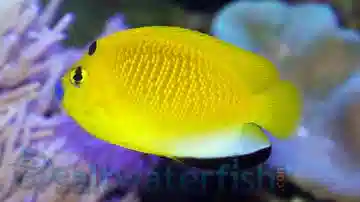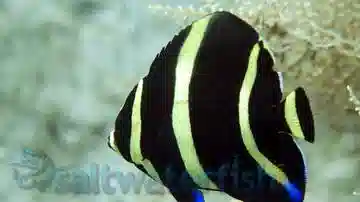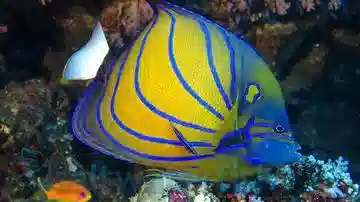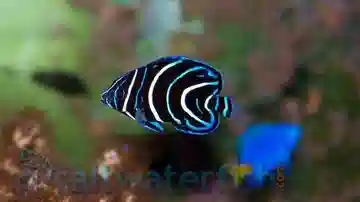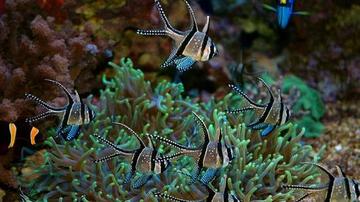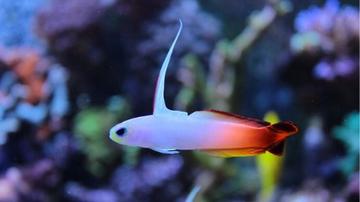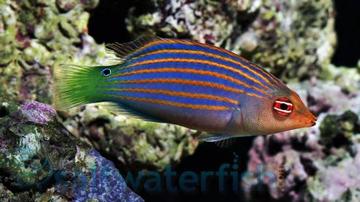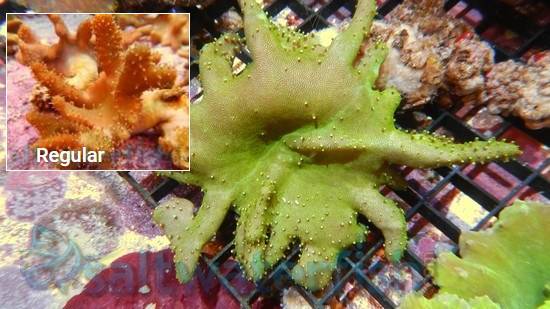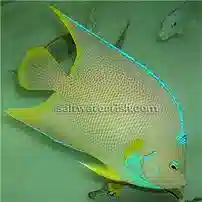Blue Angelfish: Juvenile
Holacanthus isabelita
(0 Reviews)
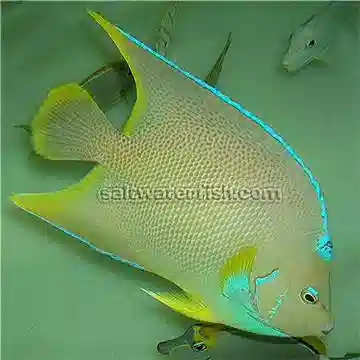
Blue Angelfish: Juvenile
Holacanthus isabelita
(0 Reviews)
{{ item.name }}
Size: {{ item.extra_field_3 }}
${{ getFormattedPrice(item.saleprice) }} ${{ getFormattedPrice(item.price) }}
To join the waiting list, click here
Free Shipping
With
$199.00
or more in Marine Life.
More details...
Blue Angelfish: Juvenile Care Facts
| Care Level: | Moderate |
|---|---|
| Temperament: | Peaceful - Maybe aggresiive within its own species |
| Reef Safe: | Juvenile Stage Only |
| Diet: | Greens, Meaty foods, prepared foods |
| Origin: | Caribbean |
| Acclimation Time: | 3+ hours |
| Coral Safe: | No |
| Invertebrate Safe: | May eat worms and some small invertebrates |
| Minimum Tank Size: | 130 + gallons |
Blue Angelfish (Holacanthus isabelita): A Comprehensive Guide
Welcome to the stunning and charismatic world of the Blue Angelfish ( Holacanthus isabelita), a cherished treasure in the realm of saltwater marine aquariums. This remarkable fish, celebrated for its striking appearance and captivating behavior, promises to be a standout in any well-maintained aquarium setup. With its unique characteristics and compatibility, the Blue Angelfish has captured the fascination of both seasoned aquarists and enthusiasts, venturing into the captivating world of marine fishkeeping.
Habitat: Discovering the Blue Angelfish's Natural Home
The Blue Angelfish is native to the crystal-clear waters of the Western Atlantic Ocean, particularly in the Western Caribbean and Bermuda. It is typically found in coral-rich reefs, rocky outcrops, and other submerged structures, displaying its vivid coloration against the backdrop of its natural habitat.
Reef Compatibility: Assessing Compatibility with Coral Reefs
When evaluating reef compatibility, it's essential to exercise caution with the Blue Angelfish. While they are generally not considered reef-safe, some individuals may prefer nipping at certain corals, particularly soft corals and polyps. It's advisable to monitor their behavior closely when introducing them to a reef environment and to ensure a well-fed diet to minimize potential coral grazing.
Size and Lifespan: Understanding Growth and Longevity
The Blue Angelfish boasts an elongated, vibrant blue body and distinctive markings. It typically grows to 12-15 inches in the wild. In captivity, they often reach a size of around 8-10 inches. When provided with proper care and an ideal environment, these remarkable fish can live for over 15 years, offering aquarists a long-term companion with captivating beauty.
Diet in Captivity: Providing Proper Nutrition
To ensure the health and vibrancy of the Blue Angelfish in captivity, it's crucial to provide a well-rounded diet. In the wild, they feed on sponges, algae, and small invertebrates. In captivity, a diet of high-quality marine pellets, frozen foods like brine shrimp and mysis shrimp, and occasional servings of fresh or dried marine algae will fulfill their nutritional needs.
Aquaculture and Availability: Sourcing Your Blue Angelfish
Blue Angelfish are not found in aquaculture. Saltwaterfish.com is dedicated to providing responsibly sourced fish. This ensures that hobbyists can acquire healthy and acclimated Blue Angelfish for their aquariums, contributing to the sustainability of the species in the hobby.
Sexual Dimorphism and Variations: Distinguishing Features and Transformations
Blue Angelfish exhibit minimal sexual dimorphism, making it challenging to distinguish between males and females based on visual characteristics alone. These fish undergo a striking transformation in coloration from juvenile to adult stages. Juvenile Blue Angelfish display a vibrant blue body with vertical yellow stripes, while adults boast a rich, deep blue coloration with striking yellow patterns radiating from their eyes.
Compatibility and Temperament: Peaceful Coexistence
Blue Angelfish are known for their generally peaceful temperament, making them suitable candidates for community tanks. However, providing adequate hiding spots and territories for all tank inhabitants is essential, as territorial behavior can emerge, mainly when other angelfish are present. They tend to get along well with a variety of fish and invertebrates.
Tank Requirements: Creating the Ideal Habitat
Establishing an optimal environment for the Blue Angelfish necessitates meticulous attention to tank specifications. A tank with a minimum size of 120 gallons is recommended to accommodate their size and swimming habits. Water conditions play a pivotal role in their well-being, with a pH level between 8.1 and 8.4, a salinity level of 1.020-1.025, and a consistent temperature of 75-80°F (24-27°C), replicating its natural habitat and ensuring their thriving presence.
Common Names: Alternative Names for the Blue Angelfish
The Blue Angelfish is also known by various common names, including the Bermuda Blue Angelfish and the Yellow-Chest Angelfish.
Compatible Tank Mates: Choosing Companions for the Blue Angelfish
When selecting compatible tank mates for the Blue Angelfish, opt for species that share their peaceful nature and can coexist harmoniously. Here are five suitable companions:
- Flame Angelfish (Centropyge loriculus)
- Clown Triggerfish (Balistoides conspicillum)
- Harlequin Tuskfish (Choerodon fasciatus)
- Tomato Clownfish (Amphiprion frenatus)
- Blue-Spotted Jawfish (Opistognathus rosenblatti)
Why Choose the Blue Angelfish from Saltwaterfish.com
Saltwaterfish.com is synonymous with quality and reliability in the marine aquarium community. When acquiring a Blue Angelfish from Saltwaterfish.com, you're not just getting a captivating fish but investing in a piece of aquatic artistry. The company's commitment to providing responsibly sourced fish ensures that each Blue Angelfish is healthy, acclimated, and ready to thrive in your aquarium. With a wide range of resources and customer support, Saltwaterfish.com provides a seamless journey toward nurturing and enjoying the captivating beauty of the Blue Angelfish.
In conclusion, the Blue Angelfish (Holocanthus bermudensis) is a captivating marine species that promises to enrich any saltwater aquarium. Its striking appearance, reef compatibility, and peaceful demeanor make it a highly sought-after addition among marine enthusiasts. Aquarists can relish witnessing the Blue Angelfish flourish within their aquatic habitat by adhering to its specific requirements and considering its needs.
Currently Blue Angelfish: Juvenile does not have any reviews.


